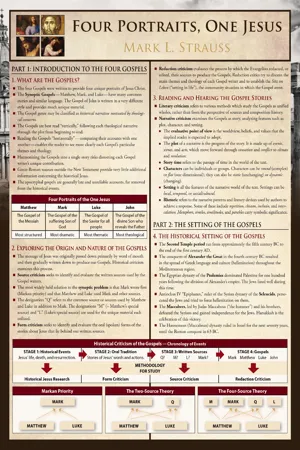
- 6 pages
- English
- ePUB (mobile friendly)
- Available on iOS & Android
Four Portraits, One Jesus Laminated Sheet
About this book
This laminated sheet accompanies Mark L. Strauss's Four Portraits, One Jesus. Following the textbook's structure, this quick-study tool offers summaries, important definitions, dates, and concepts designed to support the students' learning experience and enhance their comprehension of what can be known from the Gospels about the central defining subject of Christianity, Jesus of Nazareth.
Four Portraits, One Jesus is a thorough yet accessible introduction to the four biblical Gospels and their subject, the life and person of Jesus. Like different artists rendering the same subject using different styles and points of view, the Gospels paint four highly distinctive portraits of the same remarkable Jesus. With clarity and insight, Mark Strauss illuminates these four books, first addressing their nature, origin, methods for study, and historical, religious, and cultural backgrounds. He then moves on to closer study of each narrative and its contribution to our understanding of Jesus, investigating things such as plot, characters, and theme. Finally, he pulls it all together with a detailed examination of what the Gospels teach about Jesus’ ministry, message, death, and resurrection, with excursions into the quest for the historical Jesus and the historical reliability of the Gospels.
Frequently asked questions
- Essential is ideal for learners and professionals who enjoy exploring a wide range of subjects. Access the Essential Library with 800,000+ trusted titles and best-sellers across business, personal growth, and the humanities. Includes unlimited reading time and Standard Read Aloud voice.
- Complete: Perfect for advanced learners and researchers needing full, unrestricted access. Unlock 1.4M+ books across hundreds of subjects, including academic and specialized titles. The Complete Plan also includes advanced features like Premium Read Aloud and Research Assistant.
Please note we cannot support devices running on iOS 13 and Android 7 or earlier. Learn more about using the app.
Information
PART 1: INTRODUCTION TO THE FOUR GOSPELS
1. WHAT ARE THE GOSPELS?
| Four Portraits of the One Jesus | |||
| Matthew | Mark | Luke | John |
| The Gospel of the Messiah | The Gospel of the suffering Son of God | The Gospel of the Savior for all people | The Gospel of the divine Son who reveals the Father |
| Most structured | Most dramatic | Most thematic | Most theological |
2. EXPLORING THE ORIGIN AND NATURE OF THE GOSPELS
3. READING AND HEARING THE GOSPEL STORIES
PART 2: THE SETTING OF THE GOSPELS
4. THE HISTORICAL SETTING OF THE GOSPELS
Table of contents
- COVER PAGE
- TITLE PAGE
- COPYRIGHT PAGE
- CONTENTS
- PART 1: INTRODUCTION TO THE FOUR GOSPELS
- PART 2: THE SETTING OF THE GOSPELS
- PART 3: THE FOUR GOSPELS
- PART 4: THE HISTORICAL JESUS